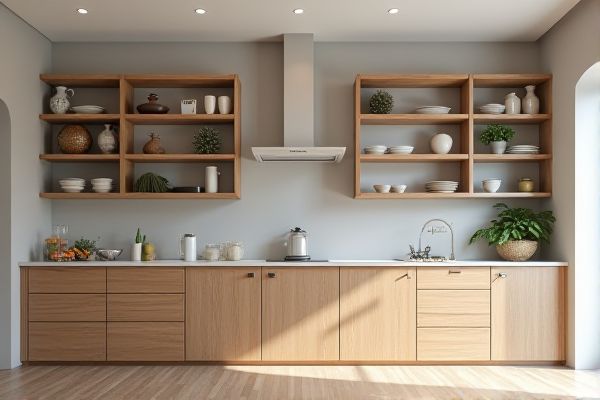
Open shelves provide easy access and showcase your items for a more spacious and decorative look, while closed cabinets offer concealed storage that keeps your space tidy and protected from dust. Explore the rest of the article to discover which option best suits Your storage needs and style preferences.
Table of Comparison
| Feature | Open Shelves | Closed Cabinets |
|---|---|---|
| Accessibility | Easy access, items visible | Items hidden, requires opening doors |
| Storage Capacity | Limited to displayed items | Maximized, including concealed storage |
| Maintenance | Requires frequent dusting | Less dust exposure, easier upkeep |
| Design Aesthetic | Airy, modern, showcases decor | Clean, organized, hides clutter |
| Cost | Generally lower price | Usually higher due to materials and hardware |
| Customization | Limited structural options | Highly customizable with shelves and compartments |
| Best Use | Display items, easy reach in kitchens/living rooms | Conceal storage, protect items in kitchens/bathrooms |
Introduction to Open Shelves and Closed Cabinets
Open shelves provide easy access and display of items, enhancing kitchen visibility and airflow, while closed cabinets offer concealed storage that protects contents from dust and provides a streamlined look. Choosing between open shelves and closed cabinets depends on the balance of aesthetics, functionality, and maintenance preferences in interior design. Both storage solutions cater to different organizational needs, influencing overall kitchen efficiency and style.
Aesthetic Differences: Visual Appeal and Style
Open shelves create a light, airy aesthetic by showcasing decorative items and easy access to frequently used objects, enhancing your kitchen or living space's visual appeal. Closed cabinets offer a sleek, uniform look that conceals clutter, contributing to a minimalist and polished style ideal for a clean and organized environment. Choosing between them depends on whether you prefer an open, dynamic display or a streamlined, discreet storage solution.
Space Efficiency and Storage Capacity
Open shelves maximize accessibility and visual space, making them ideal for frequently used items but often offer less protection from dust and clutter compared to closed cabinets. Closed cabinets provide greater storage capacity with concealed organization, utilizing vertical space efficiently and safeguarding contents from dirt and damage. Combining both solutions can optimize overall space efficiency by balancing easy access with ample, protected storage.
Accessibility and Ease of Use
Open shelves offer immediate accessibility, allowing users to quickly locate and retrieve items without the need to open doors or drawers. Closed cabinets protect contents from dust and provide a more organized appearance but may require extra effort to access stored items. For kitchens or workspaces demanding frequent use and visibility, open shelves enhance ease of use, while closed cabinets suit environments prioritizing protection and tidiness.
Organization and Clutter Management
Open shelves promote easy access and visibility, allowing for quick organization of frequently used items, but they can also expose clutter if not regularly maintained. Closed cabinets offer concealed storage, effectively hiding mess and reducing visual clutter, which helps maintain a clean and streamlined appearance. Choosing between the two depends on the balance between accessibility needs and the desire for a tidy, clutter-free space.
Maintenance and Cleaning Requirements
Open shelves require frequent dusting and cleaning to prevent buildup since items are fully exposed to air and contaminants, making maintenance more time-consuming compared to closed cabinets. Closed cabinets protect contents from dust and spills, reducing cleaning frequency and preserving item condition, which significantly lowers ongoing maintenance efforts. Materials like glass-front closed cabinets balance visibility and protection, easing cleaning while still showcasing items.
Cost Comparison: Budget Considerations
Open shelves typically cost less than closed cabinets due to lower material and labor expenses, making them a budget-friendly option for those looking to save on storage solutions. Closed cabinets involve extra costs for doors, hardware, and more complex installation, which can significantly increase the overall price. When planning your kitchen or storage area, choosing open shelves can provide a cost-effective way to maximize space without compromising on style or function.
Impact on Room Lighting and Perception
Open shelves enhance room lighting by allowing natural and artificial light to flow freely, creating a brighter and more spacious atmosphere. Closed cabinets tend to absorb or block light, making the room feel smaller and more enclosed, which can impact the overall perception of space. You can strategically choose between open shelves and closed cabinets to optimize lighting and create an airy ambiance or a more cozy, intimate environment.
Suitability for Different Rooms and Uses
Open shelves are ideal for kitchens and living rooms where quick access to frequently used items like spices or decorative pieces enhances functionality and aesthetics. Closed cabinets suit bedrooms and bathrooms better by providing concealed storage that protects belongings from dust and maintains a tidy appearance. Your choice between open shelves and closed cabinets should align with the room's purpose and the level of organization or display you desire.
Final Thoughts: Choosing Between Open Shelving and Closed Cabinets
Open shelves offer easy access and create an airy, visually spacious kitchen, ideal for displaying dishware and decor, while closed cabinets provide concealed storage that protects items from dust and maintains a streamlined appearance. Consider kitchen size, lifestyle, and organizational preferences when deciding; open shelving suits minimalist and frequently used items, whereas closed cabinets are better for hiding clutter and storing less attractive cookware. Balancing aesthetics with practicality ensures the chosen solution enhances functionality and complements the overall kitchen design.
 homyna.com
homyna.com